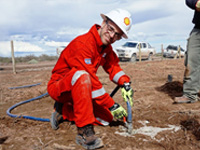Argentina - "The Unconventional Tree", carried out by Shell, Halkis and Groatec
 On September 17, 2018 the project, The Unconventional Tree, started in Nuequén, Argentina. This (pilot) project is being carried out by three different parties: Shell is part of this project as owner and promoter; The company Halkis agriculture provides technical support for the project; Groatec is the official distributor of Groasis from the Netherlands and takes care of the delivery of the Growboxx® plant cocoons.
On September 17, 2018 the project, The Unconventional Tree, started in Nuequén, Argentina. This (pilot) project is being carried out by three different parties: Shell is part of this project as owner and promoter; The company Halkis agriculture provides technical support for the project; Groatec is the official distributor of Groasis from the Netherlands and takes care of the delivery of the Growboxx® plant cocoons.
In addition to these parties, other organizations will join the process later when their expertise is required for the implementation of the project.
Reducing the impact of oil and gas activities on nature
The main goal of this project is to see if the CO₂ impact of oil and gas activities can be reduced to a minimum.
A total of 1.5 hectares with 630 productive trees (olives, eucalyptus, acacia and elm) and 1,400 shrubs (Zampa and Molle) are planted with the biodegradable Growboxx® plant cocoon. All crops are planted in 4 different areas. All areas have their own objectives:
- The effects on habitability
- Animal welfare
- Impact on the environment
- Limitation of water and erosion
The areas now have a vegetation coverage of 25% to 45%. The soil has a clay structure and is not salty.
The Growboxx® plant cocoons will be filled with water once during planting. There is also no water available in the dry area to refill them during the project.
Goals of the project
The project, the Unconventional Tree, has various objectives. In addition, there are also several advantages for the environment. The objectives and benefits of this project are:
- Improve the environment and see what the impact is when planting various trees and shrubs;
- What the effect is for sustainability on CO₂ emissions, with an improvement in our environment;
- What does this project mean for Shell's reputation;
- Innovation for agriculture in the region, can we increase productivity without irrigation;
- The integration of aesthetic and functional standards, at the same time improving the environment and maintaining comfortable spaces in the field of work and facilities and contributing to the control of dust emissions;
- In the generation of alliances with important sectors of the community, such as the integration of technical schools in agriculture and the generation of basic products for social and / or productive investment programs.
The objectives of this project are related to:
- Replant the dry and eroded areas with trees and shrubs with a technology that has worldwide recognition;
- Develop a model based on this project so that environmental improvement becomes scalable.
What results are expected in the execution of the project?
At the end of this project
- Through the development of this project we gain insight into the possibility of achieving the objectives;
- A survival rate of at least 90% is expected in June 2019 (and also five years after planting the trees) for both trees and shrubs;
- By the fifth plant year, June 2023, the intention is to have at least one vegetation cover of 60% to 80%.
- A year after planting it is expected that a scalable environmental improvement model can be drawn up based on the results achieved so that it can be implemented in other areas.
Click here to view the photos of the planting and the results after three weeks















